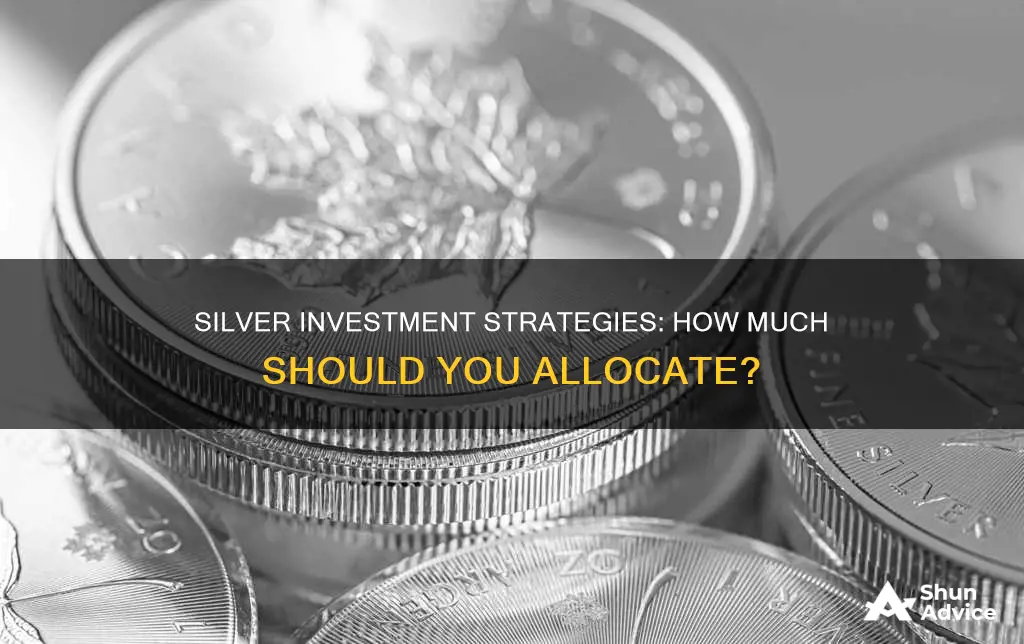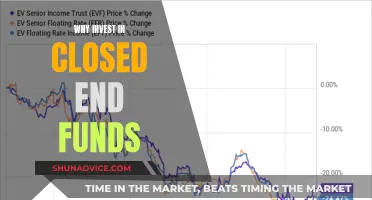
Silver is a precious metal that is often viewed as a good investment option. It is considered a safe haven during economic instability and a hedge against inflation. Silver's price is influenced by industrial demand and its extensive use in manufacturing electronics, solar panels, electric vehicles, and other goods. Its price is more volatile than gold, making it a riskier investment with potential for higher profits in a bull market but larger losses in a bear market.
When deciding how much to invest in silver, it is essential to consider your financial goals, risk tolerance, and the health of your existing portfolio. While silver can be a valuable addition to your investment portfolio, it should only make up a small percentage of your overall portfolio. A well-diversified portfolio of stocks, bonds, mutual funds, or ETFs will likely provide better returns over time.
There are several ways to invest in silver, including buying physical silver, trading silver futures, purchasing ETFs that own silver, investing in silver mining stocks, or buying ETFs that hold silver miners. Each method has its own risks and rewards, so it is important to carefully consider which approach aligns with your investment strategy and goals.
| Characteristics | Values |
|---|---|
| Silver's industrial uses | Silver is used in electronics, automobiles, mirrors, water purifiers, solar panels, and electric vehicles. |
| Volatility | Silver is more volatile than gold. |
| Price | Silver is much cheaper than gold. |
| Supply | Silver's supply is constrained by mining production and recycling. |
| Demand | Demand for silver is influenced by industrial demand and consumer demand for silver jewellery. |
| Historical price performance | Silver's price has outpaced inflation over the very long term. |
| Short-term price performance | Silver can be quite volatile in shorter time increments. |
| Investment options | Options include junk coins, bullion, futures and options, mining stocks, streaming stocks, and IRAs. |
| Investor profile | Silver may be more suitable for younger investors with a higher risk tolerance. |
What You'll Learn

Silver as a store of value
Silver is a precious metal that has been used as a store of value for centuries. It is often referred to as "poor man's gold" due to its affordability compared to gold. Silver can be a good investment option, especially during uncertain economic times, as it can behave differently from stocks and bonds.
Hedge Against Inflation
Silver is seen as a hedge against inflation or declines in purchasing power. As a real asset with a limited supply, its value can increase when the purchasing power of fiat currencies decreases. Silver's value is tied to its industrial uses and demand from various sectors, including electronics, solar panels, electric vehicles, and healthcare equipment.
Safe-Haven Investment
Silver, like gold, is considered a safe-haven investment during times of economic uncertainty or geopolitical instability. When stocks or other assets decline due to market worries, silver often moves in the opposite direction, providing a cushion for investors.
Long-Term Store of Value
Silver has a long history of being used as a medium of exchange and a store of value. Its purchasing power has outpaced inflation over the very long term. For example, from February 1915 to September 2024, the inflation-adjusted price of silver rose by more than 90%. While shorter time periods can be more volatile, silver has proven to be a reliable store of value over the long term.
Portfolio Diversification and Diversification
Silver can play a crucial role in diversifying an investment portfolio. It is less correlated to traditional asset markets like stocks, meaning it can move independently and provide a hedge against market downturns. Adding silver to a portfolio can reduce risk and potentially increase returns.
Tangible and Portable Asset
Silver, in its physical form, is a tangible and portable asset. It can be easily bought, sold, and stored, providing investors with more control and flexibility compared to other investment options.
While silver has its advantages as a store of value, it's important to remember that it is a volatile asset. The silver market is smaller than the gold market, and its price can be subject to significant swings. Therefore, investors should carefully consider their risk tolerance and financial goals before allocating a portion of their portfolio to silver.
Mutual Funds: Diversify Your Portfolio, Maximize Returns
You may want to see also

Silver's industrial uses
Silver has a wide range of industrial uses, which account for more than half of the annual demand worldwide. Its unique properties, such as its high electrical and thermal conductivity, reflectivity, and antimicrobial qualities, make it an indispensable metal in various sectors. Here are some of the key industrial applications of silver:
Electronics and Electrical Components: Silver is essential in the electronics industry, with over 50% of global silver consumption attributed to this sector. It is used in the manufacturing of printed circuit boards, semiconductors, electrical contacts, and batteries. Silver enables efficient electron flow between conductive materials, ensuring minimal energy loss during transmission, which makes our devices more efficient and reliable.
Solar Energy: Silver's sensitivity to light makes it valuable in the photovoltaic or solar energy industry. Silver is used as a conductive ink in photovoltaic cells, which convert sunlight into electricity. The growing demand for renewable energy sources, such as solar power, is expected to increase the demand for silver.
Medicine and Healthcare: Silver has been used in medicine for thousands of years due to its antimicrobial properties. It is highly effective in inhibiting the growth of bacteria, viruses, and other pathogens, helping to prevent infections and promote healing. Silver is used in medical equipment, such as breathing tubes, catheters, bandages, and ointments, to prevent bacterial infections and improve patient outcomes.
Other Applications: Silver is also used in a variety of other industrial applications, including solder and brazing alloys, dentistry, glass coatings, LED chips, nuclear reactors, photography, RFID chips, touch screens, water purification, and wood preservatives. Its physical strength, brilliance, malleability, and ductility make it a versatile material for various industries.
With its unique properties and diverse applications, silver plays a crucial role in numerous industries, and its demand is expected to grow, particularly with the shift towards clean energy technologies and advancements in healthcare.
Investing in NVIDIA: Top Mutual Funds to Consider
You may want to see also

Volatility in the silver market
Silver is a volatile asset, and its market is subject to significant price swings. This volatility is driven by several factors, including its dual nature as a precious and industrial metal, global economic conditions, and the actions of central banks and large financial institutions.
Firstly, silver's volatility is influenced by its dual classification as a precious and industrial metal. As a precious metal, silver is often viewed as a hedge against inflation and a store of value, similar to gold. However, silver also has industrial applications in electronics, automobiles, solar panels, and electric vehicles. This industrial demand can cause silver prices to be more closely tied to economic cycles than gold, leading to increased volatility.
Secondly, the size of the silver market compared to the gold market contributes to its volatility. Silver is much cheaper than gold, and each dollar invested in silver represents a larger percentage of its price. As a result, percentage changes in silver prices can be more pronounced than gold, even when they move in the same direction.
Additionally, global economic conditions and geopolitical uncertainties can impact silver prices. During periods of economic growth and rising consumer prices, the demand for goods containing silver increases, which can drive up silver prices. On the other hand, during economic downturns or periods of uncertainty, silver may be seen as a safe-haven investment, causing its price to rise.
Moreover, the actions of central banks and large financial institutions can significantly influence the silver market. For example, if central banks begin purchasing silver, as Russia recently announced, it could increase demand and drive up prices. Similarly, large financial institutions, such as JPMorgan, have been accused of manipulating silver prices through practices like spoofing, which involves placing bids or offers with the intent to cancel them before execution. These actions can create artificial price movements and contribute to the volatility in the silver market.
In conclusion, the volatility in the silver market is influenced by a combination of factors, including its dual nature as a precious and industrial metal, global economic conditions, and the actions of central banks and large financial institutions. This volatility presents increased opportunities for intraday traders and those seeking to profit from short-term price movements. However, it also creates challenges for long-term investors, who may experience significant price fluctuations in their silver holdings.
Growth Investment Funds: How to Invest and Grow Your Money
You may want to see also

Silver's performance vs the S&P 500
Silver is a precious metal that has historically been an alternative investment to stocks and bonds. Silver's value comes from its scarcity, and it is also used in electronics, medical applications, batteries, and solar panels.
Silver is more volatile than gold because it is much cheaper, and its market is smaller. Silver's price movements are often tied to boom-and-bust economic cycles.
Over the last five decades, silver has outperformed the S&P 500 in only three of the eight recessions: 1973, 1981, and 2007. In March 2023, the silver nominal price was down 6.1% compared to the S&P 500, which was down 3.3%.
However, silver can provide a cushion against declines in purchasing power over the long term. From February 1915 to September 2023, the inflation-adjusted price of silver rose more than 90%, outpacing inflation.
The decision to invest in silver depends on your financial goals. If you are seeking stability and a hedge against economic shocks, gold may be a better choice. If you want an asset with a higher rate of return and the potential for higher gains, then silver could be a larger percentage of your portfolio.
It is generally recommended to hold between 5% and 20% of your portfolio in precious metals, depending on your specific goals and risk tolerance.
Investing in Jackson Heights: Opportunity Fund Guide
You may want to see also

Silver vs gold
Silver and gold are both precious metals that can be attractive to investors, especially in times of market volatility. However, there are several differences between the two metals that investors should consider when deciding how much of their portfolio to allocate to each. Here are some key points to consider when comparing silver vs. gold as investment options:
Silver May Be More Tied to the Global Economy
Half of all silver is used in heavy industry and high technology, including electronics, smartphones, automobiles, and solar panels, according to the World Silver Survey. As a result, silver demand tends to increase when economies are doing well, and it is more sensitive to economic changes than gold. Gold, on the other hand, has limited uses beyond jewellery and investment purposes.
Silver Is More Volatile than Gold
The volatility in silver prices can be two to three times greater than that of gold on a given day. While this volatility can be beneficial for traders, it can also be challenging when managing portfolio risk. Silver is considered a high-risk, high-return investment.
Gold Has Been a More Powerful Diversifier than Silver
Although silver is a good portfolio diversifier with a moderately weak positive correlation to stocks, bonds, and commodities, gold is considered even better. Gold has consistently shown low or no correlation to stocks and other major asset classes because its value is less affected by economic declines due to its limited industrial uses.
Silver Is Currently Cheaper than Gold
Per ounce, silver tends to be significantly cheaper than gold, making it more accessible to small retail investors who wish to own precious metals as physical assets. Silver is often referred to as "poor man's gold" and is a good option for those with smaller amounts of cash to invest.
Long-term Performance
Historically, gold has performed more strongly than silver. For example, an investment of $5,000 in gold in January 2010 would have been worth $9,462 by January 2024, an 89% increase. Meanwhile, the same investment in silver would have been worth $5,052, a 1% increase.
Ways to Invest in Gold and Silver
There are several ways to invest in gold and silver beyond simply hoarding jewellery:
- Buy physical pieces such as gold bars or silver coins.
- Invest in gold or silver mutual funds or exchange-traded funds (ETFs) that track industry trends or precious metal prices.
- Invest in associated industries, such as mining companies.
Overall Recommendations
The percentage of investment funds allocated to silver or gold should depend on individual goals, risk tolerance, and financial situation. In general, precious metals should only make up a small percentage of an overall portfolio, as a well-diversified portfolio of stocks will likely outperform the prices of gold or silver over time. Gold is generally considered a safer long-term investment due to its lower volatility, while silver may be more suitable for those seeking higher returns who can tolerate the higher risk.
Collaborative Fund Investment: Strategies for Success
You may want to see also
Frequently asked questions
There is no one-size-fits-all answer to this question as it depends on various factors, including your financial goals, risk tolerance, and investment horizon. However, a common recommendation is to allocate between 5% and 20% of your portfolio to precious metals, which can include both gold and silver.
Silver is considered a precious metal and has long been valued for its use in jewellery, coins, and other decorative items. Additionally, silver has a range of industrial applications, including its use in electronics, solar panels, and electric vehicles. As a result, silver can offer investors a hedge against economic downturns and inflation while also providing exposure to the growth of key industries.
Silver is a volatile asset, and its price can fluctuate significantly in the short term. Additionally, owning physical silver comes with the risk of theft or loss, and it may be challenging to sell quickly in an emergency. Finally, silver does not provide cash flow or dividends, so investors rely solely on price appreciation for returns.







